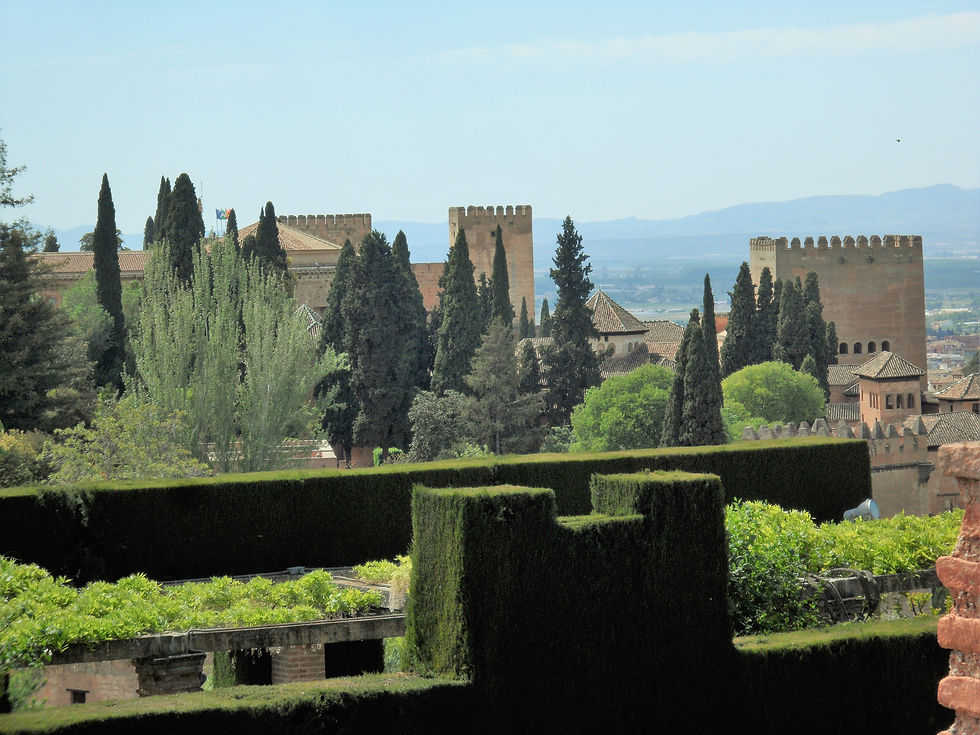Andalusia: splendor of light, baroque churches and mosques
- Angelo e Adele
- Jun 22, 2019
- 4 min read
Updated: Jan 5, 2023
As we announced in the last newsletter, here we are to tell you about our most recent trip. We are talking about a tour in Andalusia, which we did between April and May 2019. They were eight very intense days, excellently organized by our trusted tour operator Movimondo in collaboration with the Strabordo association, with whom we have been traveling for nine years now. We arrived and left by plane from Malaga; we moved by bus, touching Granada, Ronda, Seville and Cordoba, with overnight stays in Malaga and Seville. All this with the help of local guides who spoke Italian and above all accompanied and supported by the excellent Emanuele and Mauro; without their organization and management of the tour it would have been impossible to cover so many destinations in such a short time after all. Throughout the tour we can say that we have been "submerged" by the testimonies of Arab and Christian cultures, sometimes in opposition, sometimes overlapping or even integrating one into the other. And then let's start taking a look at these splendid cities, beginning from where it all started, that is from MALAGA. City Hall:

The Roman Theater:

Picasso's birthplace and his statue in Plaza de la Merced:


a street in the center, which is largely paved in marble, a pleasure for those who travel in a wheelchair:

some images of the Cathedral, which brings together late Gothic, Neo-Gothic, Classicism and Baroque in its majestic forms:



The Archbishop's Palace:

some images taken from the Castillo de Gibralfaro, a stronghold from which you can enjoy a splendid view of the city, with some roughness for wheelchairs:





And finally, an injection of contemporary: Malaga is in fact home to a branch of the very famous Center Pompidou in Paris, the one designed by our Renzo Piano. Here are some pictures of the exterior of the structure and some paintings housed in it:



a painting by Mirò:

and one by Picasso, whose Museum we were unable to visit:

The second city we visited is GRANADA; the main attraction was of course the Alhambra, or "red castle", the military citadel that became the palace of the sultans of Granada in the mid-13th century:



the gardens of Generalife:





the Palace of Charles V:

the Alcàzar, that is the residence of the Arab sovereigns:





the Patio de los Leones:




RONDA: this is perhaps the least known of the Andalusian cities, but it is inserted in a unique naturalistic context. The city is divided in two by a very deep rift (tajo) generated by the Guadalevin river, and the two parts are connected by the Puente Nuevo:



A look at the Plaza de Toros:







A look at the historic center of Ronda:



We have now arrived at the capital of Andalusia, SEVILLE. It is a city of just under 700 thousand inhabitants, crossed by the Guadalquivir river, with a very large and pedestrianized historic center. Let's take a look at the banks of the river:


the Torre del Oro, built by the Arabs in 1220 with a coating in gilded azulejos, now disappeared:

the Reales Alcàzares, a palace-fortress built by the Arabs and subsequently transformed by the Catholic kings, are still the Sevillian residence of the Spanish royals:









the splendid Jardines del Alcàzar:





Let's now pass to describe the Cathedral of Seville. Built as a mosque by the Arab sovereigns, it was converted into a Catholic church in 1248 and between 1402 and 1506 transformed into a grandiose monument to Christianity:




la Giralda, an ancient Arab minaret transformed into a bell tower in the 16th century with the addition of the upper part and the statue of the Faith called Giraldillo as it rotates:

the interior of the Cathedral:

the tomb of Christopher Columbus:


the Cathedral at night:

Let's now pass to the most scenic square in Seville, Plaza de Espana, with its 48 ceramic panels, each for each Spanish province and the four bridges over the canal, one for each ancient kingdom of Spain:





Some pictures of the beautiful buildings in the center:



And now let's move on to the Casa de Pilatos, so called because the owner, upon returning from a trip to the Holy Land, discovered that the family residence was as far from the church of the Cruz del Campo as that of Pilate from Golgotha:




The Bearded Woman:



And we close our short visit to Seville with the futuristic and controversial construction inaugurated in 2011 and called Metropol Parasol or commonly Las Setas (mushrooms). There are gigantic columns supporting a weave of wood and natural materials that offer shade from the scorching Sevillian sun; the structure houses a market, shops, bars, a restaurant on the terrace and offers a magnificent view of the city, even if not 100% accessible by wheelchair:





We left the city of CORDOBA for last because it is the one that contains, in our opinion, the most extraordinary architectural testimony of the Arab culture that dominated between the eighth and eleventh centuries. We are talking about the splendid Mezquita Catedral or Cathedral Mosque, built between 786 and 788 on a Visigothic basilica dedicated to St. Vincent and transformed into a church after the Christian conquest of 1236. Let's leave the word to the images:







Cordoba is also nice to walk around in the alleys of the old center, among which this delightful, albeit hyper-touristy, Calle de Las Flores stands out:


We close the visit to Cordoba and our Andalusian tour with a testimony of an older civilization than the Christian and Arab ones; we are talking about the Roman civilization, which left this majestic bridge over the Guadalquivir, built in the 1st century BC. and subsequently expanded by the Arabs:

We greet the readers of COMMA 2 with a nice photo of the group that participated in this wonderful journey:


Comments